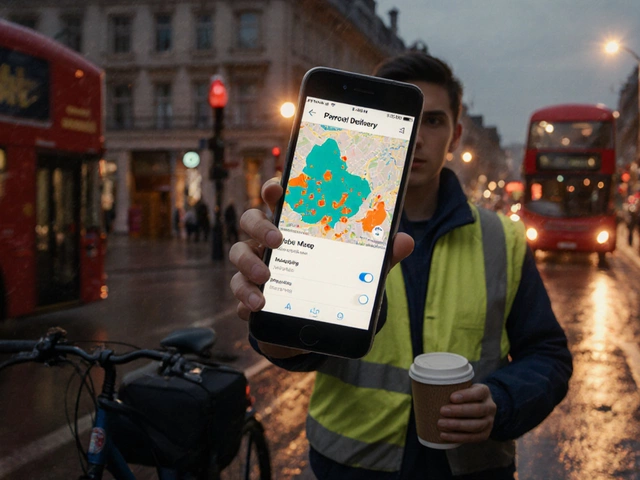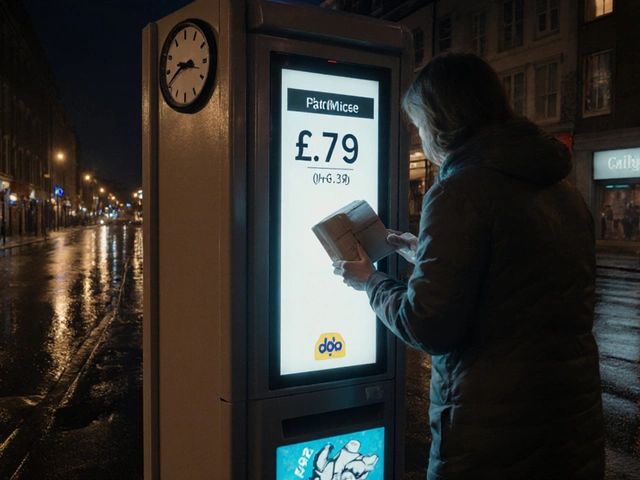You know that sinking feeling when you bust it all day behind the wheel, phone buzzing with orders, and then your paycheck shows up looking like it's been on a diet? Your rate per mile is everything, but how do you even know what's fair these days? Some companies dangle impressive numbers, but real-world math often tells a different story. There's a reason why drivers swap payout screenshots and vent in online forums every night—per mile pay isn’t always straight-up, but knowing the numbers helps you back yourself up in conversations with bosses, customers, and even when plotting your next career move. So let’s break down what actually makes a good rate per mile, what companies are really paying out this year, and how you can tip the scales in your own favor out there on the road.
What’s the Going Rate Per Mile in 2025? Facts That Might Surprise You
The big headline: average per-mile pay is higher than it was a few years back, but not by as much as you might hope. The pandemic triggered a huge delivery boom, pushing up demand for drivers at companies ranging from FedEx to gig apps to small-town courier outfits. According to the 2025 National Load Carrier Survey, the average base rate for independent drivers sits at $0.63 per mile—a bump from $0.56 in 2022. But here’s the catch: the range is huge. Some local courier gigs still pay as little as $0.35 per mile, especially if they offer a set hourly wage as well. Big-name OTR (over-the-road) trucking companies are advertising up to $0.80 per mile for experienced Class A drivers, but that’s usually for long-haul runs, no home time, and higher insurance risks.
Here’s a look at the current going rates, pulled from a ton of recent driver pay stubs, job boards, and company statements. This table makes it easier to spot where you land in the mix:
| Type of Delivery | Average Pay Per Mile | Low-End Pay | High-End Pay | Notes |
|---|---|---|---|---|
| Local courier/gig app | $0.42 | $0.30 | $0.64 | Often with tips, sometimes base plus per mile |
| Regional (in-state) carrier | $0.59 | $0.45 | $0.75 | Some pay by loaded mile only |
| Long-haul OTR trucking | $0.66 | $0.50 | $0.82 | Experienced, commercial license required |
| Expedited freight/sprinter van | $0.74 | $0.60 | $1.05 | Fast turnarounds, often team driving |
Notice how the rates spike for jobs that need a special license or involve strict delivery times. It’s not just about size of vehicle, but about responsibility and speed. But here’s a sleeper factor: some services pay only for loaded miles (when you’ve got a package on board). That means the trip to pick up, or deadhead miles on the way home, don’t count for pay. Trust me, those empty miles add up—especially if you’re zig-zagging through city traffic instead of sticking to open highways.
What about gig apps? DoorDash, Uber Eats, and Amazon Flex switch things up all the time. Lately, base rates per mile are sliding downward (think $0.32 to $0.48/mile), but surge pricing, bonuses, and tips can sometimes make the actual payout a lot fatter—if you work the right zones at the right times. Apps rarely show you the exact per-mile breakdown, so track your own miles using a GPS app to keep tabs on your true earnings.
Fact: There’s no government-mandated minimum wage for per-mile pay in loading and delivery gigs. The IRS does set a ‘standard mileage rate’ for deductions—which in 2025 sits at $0.67—but that’s for tax purposes, so don’t mix it up with what you should get from your employer or gig.

What Factors Decide Your Per-Mile Pay? Know What’s Behind the Numbers
This can feel like a dirty secret: two drivers, both pulling 200 miles a day, can walk home with paychecks that don’t even look like they’re from the same industry. Why? There’s a soup of reasons. Location is a big one. If you’re hauling boxes in rural Nebraska, the rates will look nothing like what you snag zigzagging through LA traffic. Companies in high-cost areas often pay a pinch more, but sometimes the extra cash just covers your gas guzzling.
The type of cargo changes the game. Hazardous chemicals? Fragile electronics that need white-glove handling? Expect a few more cents per mile. The same’s true for jobs that need a CDL, background checks, or specialty insurance. Somebody who only hauls fast food is going to see a different range than somebody moving Class 8 big rigs stacked with medical equipment.
A lot of drivers get side-swiped by the pay structure. Is the company paying for ALL miles, or only the loaded, billable ones? Does the rate include things like delays in traffic, waiting at pickup, weather shutdowns, and mechanical breakdowns? Most per-mile contracts don’t, and waiting for a warehouse clerk to find the paperwork can burn forty minutes off your clock—with no pay. Hourly pay plus per-mile combos can patch those holes for in-town jobs, but pure per-mile gigs leave you on your own.
Let’s not forget your rig. Driving your own vehicle? Expenses like gas, maintenance, insurance, and wear-and-tear eat into that glossy per-mile rate. A 2018 study by FleetOwner pegged vehicle operating costs at $0.49 per mile for vans and light trucks—that’s before you pay yourself for your time. If you’re leasing or driving a company vehicle, read your contract: some companies start drivers off with lower per-mile rates because they shoulder those maintenance headaches themselves.
Seniority and skill matter, too. Drivers who take on the ugly shifts—overnights, weather runs, last-minute call-outs—often land the better per-mile rates, bonuses, or preferred routes. Companies who need to fill tough time slots may offer short-term boosts (surge pay, as gig apps call it) to attract folks during storms or holidays. If you’re looking to move up, ask for high-stress or less-desired shifts to get on the company’s radar for better gigs.
Your own hustle plays a part as well. Drivers who learn to batch loads, plan the shortest routes, and nail those bonus and surge windows outpace people just working the bare minimum. Keeping your miles high for pay purposes while keeping your expenses low makes your take-home payout shine.

Tips to Maximize Your Per-Mile Earnings
Ready for some real talk? Getting paid better per mile isn’t just about luck or landing at the right company. It’s about playing the game smarter than the next guy. Here’s a toolkit to help you pump up those payslips.
- Track your real miles: Don’t trust the company’s numbers blindly. Get an app like MileIQ or Everlance and track every driven mile, not just the loaded ones. Sometimes there are major gaps in what you’re paid for and what you actually drive. Record everything. This is how you arm yourself for pay disputes—or for negotiating a bump.
- Push for paid deadhead miles: If you’re often driving empty back to base, bring it up. Some companies will cough up a few cents per deadhead mile if you politely insist or show them the lost time. You can’t get what you never ask for.
- Work during surges and bonuses: Timing means everything if you’re chasing gig app gold. Uber, DoorDash, and others advertise peak pay windows. Plan your shifts for those hot times—football Sundays, concert nights, holiday runs—when payout jumps.
- Share loads if possible: Some contracts let you link loads to avoid driving empty. Grab a return shipment or ride-share a route with a trusted buddy. Less empty running equals higher average per-mile profit for you.
- Deduct, deduct, deduct: At tax time, don’t miss out on mileage and expense deductions. Even if your per-mile pay seems bleak, IRS deductions add up. Get a logbook or app, keep every fuel and repair receipt, and knock hundreds or thousands off your year-end tax bill.
- Negotiate when you can: If your track record is solid, your delivery times are tight, and you’re reliable, ask for a review. Companies need experienced drivers more than ever. The worst they can say is no.
- Don’t get stuck with hidden costs: Some “high pay” companies sneak in weekly vehicle fees, uniform charges, or insurance cuts. Do the actual math before you sign. The lowest fees sometimes beat higher per-mile pay when you look at the all-in numbers.
- Upgrade your skills: CDL, HAZMAT, or even forklift certifications can unlock higher per-mile rates. Look into company-sponsored training or community college classes to gain some edge.
- Don’t fall for sign-on bonus hype: Lump sum bonuses feel great, but most are spread over months or require minimum mileage. Focus on base per-mile pay. That’s what pays the rent.
Real-world tip: Keep a “side hustle budget.” Let’s say your gig app rate fluctuates from $0.35 to $0.60 a mile, but your cost to drive is $0.46 per IRS averages. Anything under your cost, treat as practice. Only target the zones, shifts, and routes where your true take-home per mile makes the effort pay.
And don’t ignore the human side. Talk to other drivers. Join online forums. Share data and keep receipts. If you see rates dropping or new fees creeping in, band together to push back—drivers sharing info have convinced gig apps to bump pay and add tip transparency in cities across the country.
Bottom line: Your paid per mile rate is more than just a number on a spreadsheet. It’s your leverage, your fuel, your bargaining chip. Know how the game plays out, poke through the smoke and mirrors, and you’ll find a better shot at getting paid what you’re really worth on every single mile you drive.





